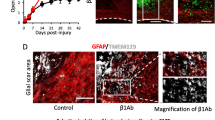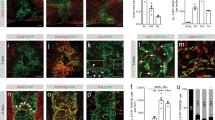Abstract
The fibrotic scar which is formed after traumatic damage of the central nervous system (CNS) is considered as a major impediment for axonal regeneration. In the process of the fibrotic scar formation, meningeal fibroblasts invade and proliferate in the lesion site to secrete extracellular matrix proteins, such as collagen and laminin. Thereafter, end feet of reactive astrocytes elaborate a glia limitans surrounding the fibrotic scar. Transforming growth factor-β1 (TGF-β1), a potent scar-inducing factor, which is upregulated after CNS injury, has been implicated in the formation of the fibrotic scar and glia limitans. In the present study, expression of receptors to TGF-β1 was examined by in situ hybridization histochemistry in transcortical knife lesions of the striatum in the mouse brain in combination with immunofluorescent staining for fibroblasts and astrocytes. Type I and type II TGF-β receptor mRNAs were barely detected in the intact brain and first found in meningeal cells near the lesion 1 day postinjury. Many cells expressing TGF-β receptors were found around the lesion site 3 days postinjury, and some of them were immunoreactive for fibronectin. After 5 days postinjury, many fibroblasts migrated from the meninges to the lesion site formed the fibrotic scar, and most of them expressed TGF-β receptors. In contrast, few of reactive astrocytes expressed the receptors throughout the postinjury period examined. These results indicate that meningeal fibroblasts not reactive astrocytes are a major target of TGF-β1 that is upregulated after CNS injury.





Similar content being viewed by others
References
Baghdassarian D, Toru-Delbauffe D, Gavaret JM, Pierre M (1993) Effects of transforming growth factor-beta 1 on the extracellular matrix and cytoskeleton of cultured astrocytes. Glia 7:193–202
Bartholdi D, Schwab ME (1997) Expression of pro-inflammatory cytokine and chemokine mRNA upon experimental spinal cord injury in mouse: an in situ hybridization study. Eur J Neurosci 9:1422–1438
Berry M, Maxwell WL, Logan A, Mathewson A, McConnell P, Ashhurst DE, Thomas GH (1983) Deposition of scar tissue in the central nervous system. Acta Neurochir Suppl (Wien) 32:31–53
De Groot CJ, Montagne L, Barten AD, Sminia P, Van Der Valk P (1999) Expression of transforming growth factor (TGF)-beta1, -beta2, and -beta3 isoforms and TGF-beta type I and type II receptors in multiple sclerosis lesions and human adult astrocyte cultures. J Neuropathol Exp Neurol 58:174–187
Fee DB, Sewell DL, Andresen K, Jacques TJ, Piaskowski S, Barger BA, Hart MN, Fabry Z (2004) Traumatic brain injury increases TGF beta RII expression on endothelial cells. Brain Res 1012:52–59
Flanders KC, Ren RF, Lippa CF (1998) Transforming growth factor-betas in neurodegenerative disease. Prog Neurobiol 54:71–85
Gimenez y Ribotta M, Menet V, Privat A (2001) The role of astrocytes in axonal regeneration in the mammalian CNS. Prog Brain Res 132:587–610
Gold LI, Sung JJ, Siebert JW, Longaker MT (1997) Type I (RI) and type II (RII) receptors for transforming growth factor-beta isoforms are expressed subsequent to transforming growth factor-beta ligands during excisional wound repair. Am J Pathol 150:209–222
Hinz B, Phan SH, Thannickal VJ, Galli A, Bochaton-Piallat ML, Gabbiani G (2007) The myofibroblast: one function, multiple origins. Am J Pathol 170:1807–1816
Homma A, Li HP, Hayashi K, Kawano Y, Kawano H (2006) Differential response of arcuate proopiomelanocortin- and neuropeptide Y-containing neurons to the lesion produced by gold thioglucose administration. J Comp Neurol 499:120–131
Ignotz RA, Massague J (1986) Transforming growth factor-beta stimulates the expression of fibronectin and collagen and their incorporation into the extracellular matrix. J Biol Chem 261:4337–4345
Kawano H, Li HP, Homma A, Kawamura K (2007) Central nervous system injury and chondroitin sulfate proteoglycans. In: Maeda N (ed) Neural proteoglycans. Research Signpost, Kerala, India, pp 215–228
Kawano H, Li HP, Sango K, Kawamura K, Raisman G (2005) Inhibition of collagen synthesis overrides the age-related failure of regeneration of nigrostriatal dopaminergic axons. J Neurosci Res 80:191–202
Klapka N, Muller HW (2006) Collagen matrix in spinal cord injury. J Neurotrauma 23:422–435
Klapka N, Hermanns S, Straten G, Masanneck C, Duis S, Hamers FP, Muller D, Zuschratter W, Muller HW (2005) Suppression of fibrous scarring in spinal cord injury of rat promotes long-distance regeneration of corticospinal tract axons, rescue of primary motoneurons in somatosensory cortex and significant functional recovery. Eur J Neurosci 22:3047–3058
Lagord C, Berry M, Logan A (2002) Expression of TGFbeta2 but not TGFbeta1 correlates with the deposition of scar tissue in the lesioned spinal cord. Mol Cell Neurosci 20:69–92
Li HP, Homma A, Sango K, Kawamura K, Raisman G, Kawano H (2007) Regeneration of nigrostriatal dopaminergic axons by degradation of chondroitin sulfate is accompanied by elimination of the fibrotic scar and glia limitans in the lesion site. J Neurosci Res 85:536–547
Lindholm D, Castren E, Kiefer R, Zafra F, Thoenen H (1992) Transforming growth factor-beta 1 in the rat brain: increase after injury and inhibition of astrocyte proliferation. J Cell Biol 117:395–400
Logan A, Frautschy SA, Gonzalez AM, Sporn MB, Baird A (1992) Enhanced expression of transforming growth factor beta 1 in the rat brain after a localized cerebral injury. Brain Res 587:216–225
Logan A, Berry M, Gonzalez AM, Frautschy SA, Sporn MB, Baird A (1994) Effects of transforming growth factor beta 1 on scar production in the injured central nervous system of the rat. Eur J Neurosci 6:355–363
Logan A, Baird A, Berry M (1999) Decorin attenuates gliotic scar formation in the rat cerebral hemisphere. Exp Neurol 159:504–510
Massague J (1992) Receptors for the TGF-beta family. Cell 69:1067–1070
Mathewson AJ, Berry M (1985) Observations on the astrocyte response to a cerebral stab wound in adult rats. Brain Res 327:61–69
Maxwell WL, Follows R, Ashhurst DE, Berry M (1990) The response of the cerebral hemisphere of the rat to injury. I. The mature rat. Philos Trans R Soc Lond B Biol Sci 328:479–500
McTigue DM, Popovich PG, Morgan TE, Stokes BT (2000) Localization of transforming growth factor-beta1 and receptor mRNA after experimental spinal cord injury. Exp Neurol 163:220–230
Merrill JE, Benveniste EN (1996) Cytokines in inflammatory brain lesions: helpful and harmful. Trends Neurosci 19:331–338
Moon LD, Fawcett JW (2001) Reduction in CNS scar formation without concomitant increase in axon regeneration following treatment of adult rat brain with a combination of antibodies to TGFbeta1 and beta2. Eur J Neurosci 14:1667–1677
Moses HL, Coffey RJ Jr, Leof EB, Lyons RM, Keski-Oja J (1987) Transforming growth factor beta regulation of cell proliferation. J Cell Physiol Suppl 5:1–7
Nakamura M, Houghtling RA, MacArthur L, Bayer BM, Bregman BS (2003) Differences in cytokine gene expression profile between acute and secondary injury in adult rat spinal cord. Exp Neurol 184:313–325
Popovich PG, Wei P, Stokes BT (1997) Cellular inflammatory response after spinal cord injury in Sprague-Dawley and Lewis rats. J Comp Neurol 377(3):443–464
Schmid P, Itin P, Cherry G, Bi C, Cox DA (1998) Enhanced expression of transforming growth factor-beta type I and type II receptors in wound granulation tissue and hypertrophic scar. Am J Pathol 152:485–493
Semple-Rowland SL, Mahatme A, Popovich PG, Green DA, Hassler G Jr, Stokes BT, Streit WJ (1995) Analysis of TGF-beta 1 gene expression in contused rat spinal cord using quantitative RT-PCR. J Neurotrauma 12:1003–1014
Shearer MC, Fawcett JW (2001) The astrocyte/meningeal cell interface–a barrier to successful nerve regeneration? Cell Tissue Res 305:267–273
Silver J, Miller JH (2004) Regeneration beyond the glial scar. Nat Rev Neurosci 5:146–156
Stichel CC, Niermann H, D’Urso D, Lausberg F, Hermanns S, Muller HW (1999) Basal membrane-depleted scar in lesioned CNS: characteristics and relationships with regenerating axons. Neuroscience 93:321–333
Streit WJ, Semple-Rowland SL, Hurley SD, Miller RC, Popovich PG, Stokes BT (1998) Cytokine mRNA profiles in contused spinal cord and axotomized facial nucleus suggest a beneficial role for inflammation and gliosis. Exp Neurol 152:74–87
Unsicker K, Strelau J (2000) Functions of transforming growth factor-beta isoforms in the nervous system. Cues based on localization and experimental in vitro and in vivo evidence. Eur J Biochem 267:6972–6975
Vivien D, Attisano L, Wrana JL, Massague J (1995) Signaling activity of homologous and heterologous transforming growth factor-beta receptor kinase complexes. J Biol Chem 270:7134–7141
Vivien D, Bernaudin M, Buisson A, Divoux D, MacKenzie ET, Nouvelot A (1998) Evidence of type I and type II transforming growth factor-beta receptors in central nervous tissues: changes induced by focal cerebral ischemia. J Neurochem 70:2296–2304
Wrana JL, Attisano L, Carcamo J, Zentella A, Doody J, Laiho M, Wang XF, Massague J (1992) TGF beta signals through a heteromeric protein kinase receptor complex. Cell 71:1003–1014
Acknowledgments
The authors would like to thank Dr. Geoffrey Raisman, UCL Institute of Neurology, Queen Square, London for reviewing the manuscript and valuable advice. This work was supported by the Ministry of Education, Science, Sports and Culture of Japan (20500318).
Author information
Authors and Affiliations
Corresponding author
Rights and permissions
About this article
Cite this article
Komuta, Y., Teng, X., Yanagisawa, H. et al. Expression of Transforming Growth Factor-β Receptors in Meningeal Fibroblasts of the Injured Mouse Brain. Cell Mol Neurobiol 30, 101–111 (2010). https://doi.org/10.1007/s10571-009-9435-x
Received:
Accepted:
Published:
Issue Date:
DOI: https://doi.org/10.1007/s10571-009-9435-x




